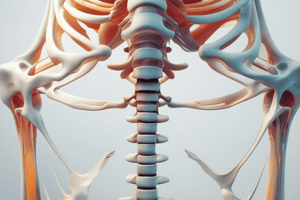Podcast
Questions and Answers
Match the following medical terminology with their definitions:
Match the following medical terminology with their definitions:
Prescription = An authorization to obtain medication Pharmacy = A place where medications are dispensed Tablet = A form of medication in solid dose Disease = An abnormal condition affecting the body
Match the following individuals with their contributions to medicine:
Match the following individuals with their contributions to medicine:
Al-Razi = Described symptoms of smallpox and measles Sadia = A character taking medicine as prescribed Adults = Responsible for checking children's medication Children = Should keep medicines out of reach
Match the objects with their protective purposes:
Match the objects with their protective purposes:
Raw egg = A small object to protect Protective clothing = Worn by sports people Sticky tape = Used to secure objects Cardboard = Material for modeling structures
Match the following terms related to medicine with their relevant contexts:
Match the following terms related to medicine with their relevant contexts:
Match the following examples with their corresponding categories:
Match the following examples with their corresponding categories:
Match the muscles with their actions:
Match the muscles with their actions:
Match the parts of the skeletal system with their functions:
Match the parts of the skeletal system with their functions:
Match the body movements with the corresponding muscle types:
Match the body movements with the corresponding muscle types:
Match the model-making materials with their attributes:
Match the model-making materials with their attributes:
Match the scientific terms with their definitions:
Match the scientific terms with their definitions:
Match the arm movements with their descriptions:
Match the arm movements with their descriptions:
Match the protective gear with their examples:
Match the protective gear with their examples:
Match the following body parts with their functions:
Match the following body parts with their functions:
Match the muscle actions with their descriptions:
Match the muscle actions with their descriptions:
Match the following organs with their location in the body:
Match the following organs with their location in the body:
Match the protective elements of the body with their specific roles:
Match the protective elements of the body with their specific roles:
Match the following terms with their related actions:
Match the following terms with their related actions:
Match the following sports equipment with their purpose:
Match the following sports equipment with their purpose:
Match each muscle type to its characteristic:
Match each muscle type to its characteristic:
Match the following body systems with their function:
Match the following body systems with their function:
Match the groups of animals with their respective types of skeletons:
Match the groups of animals with their respective types of skeletons:
Match the skeleton types with their descriptions:
Match the skeleton types with their descriptions:
Match the classification of animals with their examples:
Match the classification of animals with their examples:
Match the term with its correct function in the skeletal system:
Match the term with its correct function in the skeletal system:
Match the category of animals with their classification criteria:
Match the category of animals with their classification criteria:
Match the activities with their likely effects on breathing:
Match the activities with their likely effects on breathing:
Match the illnesses with their general symptoms:
Match the illnesses with their general symptoms:
Match the activities with their effects on the heart muscle:
Match the activities with their effects on the heart muscle:
Match the activities with their likelihood to change pulse rate:
Match the activities with their likelihood to change pulse rate:
Match the predictions with their corresponding expected outcomes:
Match the predictions with their corresponding expected outcomes:
Match the common exercises with their category:
Match the common exercises with their category:
Match the illnesses with their characteristic activities in a school survey:
Match the illnesses with their characteristic activities in a school survey:
Match the following illnesses with their appropriate treatment:
Match the following illnesses with their appropriate treatment:
Match the following terms with their definitions:
Match the following terms with their definitions:
Match the following types of medicines with their forms:
Match the following types of medicines with their forms:
Match the following symptoms with their potential conditions:
Match the following symptoms with their potential conditions:
Match the following actions with their related roles:
Match the following actions with their related roles:
Match the following medicine types with their uses:
Match the following medicine types with their uses:
Match the following medical professionals with their responsibilities:
Match the following medical professionals with their responsibilities:
Match the following medicine safety guidelines with their principles:
Match the following medicine safety guidelines with their principles:
Flashcards
Organs' protection
Organs' protection
Skeletons protect soft organs inside the body.
Muscle movement
Muscle movement
Muscles work in pairs to move the body. One contracts, the other relaxes.
Arm bending
Arm bending
Bending the arm involves the biceps contracting and the triceps relaxing.
Arm straightening
Arm straightening
Signup and view all the flashcards
Muscle pairs
Muscle pairs
Signup and view all the flashcards
Skeleton function
Skeleton function
Signup and view all the flashcards
Muscle Actions
Muscle Actions
Signup and view all the flashcards
Organ examples
Organ examples
Signup and view all the flashcards
What protects our organs?
What protects our organs?
Signup and view all the flashcards
Muscles and Movement
Muscles and Movement
Signup and view all the flashcards
Biceps and Triceps
Biceps and Triceps
Signup and view all the flashcards
What does the skeleton do?
What does the skeleton do?
Signup and view all the flashcards
What are muscles attached to?
What are muscles attached to?
Signup and view all the flashcards
How do muscles help us move?
How do muscles help us move?
Signup and view all the flashcards
What is the function of a skeleton?
What is the function of a skeleton?
Signup and view all the flashcards
What is a tendon?
What is a tendon?
Signup and view all the flashcards
Vertebrate classification
Vertebrate classification
Signup and view all the flashcards
Invertebrate classification
Invertebrate classification
Signup and view all the flashcards
Exoskeleton
Exoskeleton
Signup and view all the flashcards
Tally chart
Tally chart
Signup and view all the flashcards
Heart muscle exercise
Heart muscle exercise
Signup and view all the flashcards
Breathing pattern
Breathing pattern
Signup and view all the flashcards
Heartbeats pattern
Heartbeats pattern
Signup and view all the flashcards
Scientific words
Scientific words
Signup and view all the flashcards
Challenge yourself!
Challenge yourself!
Signup and view all the flashcards
Evidence in graphs
Evidence in graphs
Signup and view all the flashcards
Prediction
Prediction
Signup and view all the flashcards
What is medicine?
What is medicine?
Signup and view all the flashcards
What does a doctor prescribe?
What does a doctor prescribe?
Signup and view all the flashcards
What is a pharmacy?
What is a pharmacy?
Signup and view all the flashcards
What does medicine affect?
What does medicine affect?
Signup and view all the flashcards
Why is medicine safety important?
Why is medicine safety important?
Signup and view all the flashcards
What is a prescription?
What is a prescription?
Signup and view all the flashcards
What is a pharmacist?
What is a pharmacist?
Signup and view all the flashcards
Where do you get a prescription?
Where do you get a prescription?
Signup and view all the flashcards
Infectious Disease
Infectious Disease
Signup and view all the flashcards
Plant Infectious Diseases
Plant Infectious Diseases
Signup and view all the flashcards
Spread of Illness
Spread of Illness
Signup and view all the flashcards
Medicine and Illness
Medicine and Illness
Signup and view all the flashcards
Prescription
Prescription
Signup and view all the flashcards
Pharmacy
Pharmacy
Signup and view all the flashcards
Taking Medicine Safely
Taking Medicine Safely
Signup and view all the flashcards
Storage of Medicine
Storage of Medicine
Signup and view all the flashcards
Study Notes
Living Things
- All animals are living things
- All living things perform certain processes, called life processes.
- Organs in the body are part of the life processes.
The Human Skeleton
- The human skeleton is made of bones.
- Vertebrates have a backbone.
- The bones of the spine are called vertebrae.
- Humans have 206 bones.
- Bones meet at joints.
- Joints allow bones to move.
Bones Protect Organs
- Bones in the skeleton protect soft organs.
- Organs need protection.
Muscles Help Animals Move
- Muscles work in pairs.
- One muscle contracts and the other relaxes.
- This helps move the bones.
- Muscles are connected to bones by tendons.
Joints
- Joints are where two or more bones meet.
- There are different types of joints, such as ball-and-socket joints and hinge joints.
Bones and Joints
- Bones and joints work together to allow movement.
- Bones are a framework for movement, while joints allow the bones to move.
The Skeleton's Functions
- Support - the skeleton provides structure and support for the body.
- Protection - the skeleton protects critical internal organs.
- Movement - bones, along with muscles and joints, enable movement.
Studying That Suits You
Use AI to generate personalized quizzes and flashcards to suit your learning preferences.





